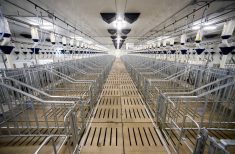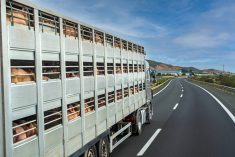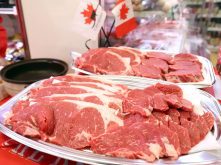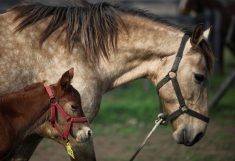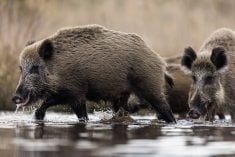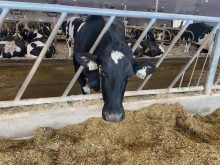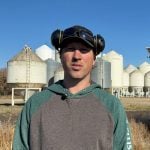A simulation meant to mimic a sudden finding of wild pigs near Selkirk, exposed gaps in disease response, pig monitoring and the need for better mapping, local outreach and agency co-ordination.
That’s according to material presented at the Canadian Wild Pig Summit II held online April 29.
WHY IT MATTERS: Manitoba industry, residents and government have been fighting to beat back invasive wild swine, which are both an ecological and agricultural threat.
Read Also

Journal pulls long-cited glyphosate study for ethics violations
The journal Regulatory Toxicology and Pharmacology has retracted a 2000 Monsanto-linked glyphosate review, drawing new scrutiny as Bayer faces mounting legal pressure.
Doug Larcombe, a field operations technician with Squeal on Pigs Manitoba, was tasked with leading the on-the-ground work for the test exercise.
The project was a collaboration with the Canadian Food Inspection Agency and Manitoba Pork Council.
Larcombe’s work is meant to raise awareness about the wild pig threat and instruct the public on how to recognize and report them. He collaborates with landowners, employing tools like drones, trail cameras, bait, and traps to help eliminate the animals once they’re found.
But finding them is often tricky. The pigs are notoriously elusive. Furthermore, they’re quite mobile. They’ve been known to travel up to 15 kilometres a night, according to from data collected through radio collars.
Simulating wild pigs
The scenario ran from Oct. 15-18 last year. The idea was to simulate a response to a wild pig finding, and then evaluate how effective the current tools, strategies and communication plans were in a real-world rural setting.
“I started with some questions…where do I start? What are the challenges going to be? What do the numbers look like? Communication, strategy, mapping, who’s going to be responsible for each process and next steps?” Larcombe said.
A key component of the project was selecting and analyzing the test site. Larcombe’s team worked in a radius of five to 10 kilometres.
“The area is a mix of urban, cropland, pastureland, bush or swampland,” he said.
That landuse breakdown came with unique aspects, he noted, Land was used heavily, and there were patches of high population density.
“The study in our environment is very different from other potential outbreak areas in our province,” Larcombe said. “The east, moving to the south, has a high population density of people, and would be a difficult area for pigs to hide themselves and their presence.”
In Manitoba, previously noted wild pig hot spots include areas such as Spruce Woods Provincial Park and the surrounding areas —landscapes with more natural cover and not as many people.
Using satellite imagery, interviews and ground scouting, Larcombe was able to evaluate pig habitat and monitor for signs of of the species.
“I tried to ensure I stopped at all the larger farms, and I used the number of grain bins as my measurement. If it was a livestock farm, I always had to keep biosecurity in mind,” he said.

Engaging the community
Door-to-door outreach was a major part of the strategy. Larcombe did interviews at 117 properties over three days and “98 people were interviewed in total … I stopped municipal employees that I saw working in the area. I went into the fields and talked to farmers that were harvesting corn.”
He also popped into office spaces to speak to staff.
Communication was handled carefully. Larcombe never shared that they were actually doing the test. Instead, he mentioned that there were wild pigs to the south of the area, and his team was checking for their presence.
“The right message will turn the community members into our helpers… the community members are who will form our ongoing monitor,” he said.
Larcombe found that business cards were especially effective.
“I had comments like, ‘I’ll put your card on the fridge.’”
Survey results
No signs of rooting or pig sightings were reported during the exercise.
Even in corn fields, a tempting food source for wild pigs, there was no rooting reported by any farmers in the area.
Backyard pigs, a biosecurity factor, given the potential for exposure should pig diseases get into local wild pigs, were also found to be minimal in the study zone.
“One farmer advised that he would sometimes keep backyard pigs, and I did see one pet pig in the area,” Larcombe said.
Dogs, on the other hand, were a real issue during the study. Larcombe got bitten twice.
Drone surveillance was hampered by both environmental and logistical barriers during the study. The team needed a temperature above -10 degrees Celsius (counting windchill) and wind speeds of less than 43 kilometres an hour.
The population density also threw another wrench in the mix. Local residents were wary about rural crime, he said, and he had heard through the grapevine that unexpected drones in the air, which residents worried were being used to scout for thefts, might meet with hostility.
Air traffic added another layer of complication. Planes, helicopters and geese were all things the team needed to be aware of.
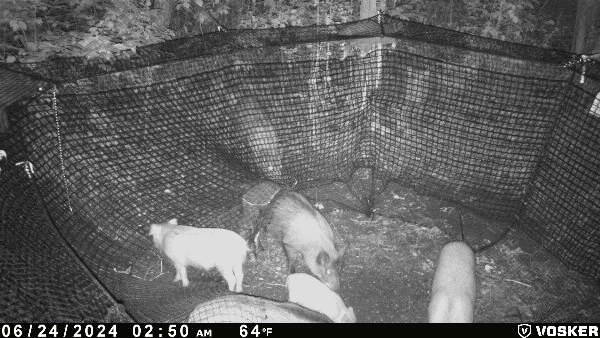
Future pig plans
For Larcombe, mapping remains the most important tool for understanding, planning, recording information and sharing knowledge about the wild pig situation.
Clear protocols, rapid development and inter-agency co-operation should all be in place before a real outbreak of wild pigs in an area occurs, Larcombe said. A 17-day system, like the one his team undertook, is simply not fast enough to be effective.
“In a real outbreak, this timeline is unacceptable,” he said. “Delays were caused by harvest, ground search and rescue, call out, time spent planning and trying to understand what was going to be expected.”
Safety, training, fencing and legal frameworks for night shooting all need to be addressed as well, Larcombe said. While the public is interested in doing their part, they should only do so with proper oversight, he added.
“There are lots of people out there that want to volunteer to help with the problem, but it would take a lot of planning to bring them into play,” he noted.
The province is actively working toward the complete removal of wild pigs from the province, Manitoba Agriculture’s website states. The invasive animals threaten both the environment and agriculture by disrupting ecosystems, damaging crops, and increasing the risk of disease transmission to both farm animals and wildlife.
The province plans to continue its work collaborating with landowners, conservation groups, and other stakeholders to remove invasive swine populations, the government website adds.



